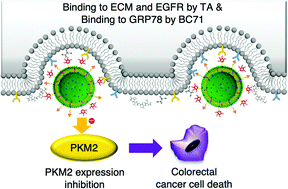Polyphenol-modified nanovesicles for synergistically enhanced in vitro tumor cell targeting and apoptosis†
Abstract
Tannic acid (TA) not only prevents drug carriers from sticking to the glycocalyx layer of vascular endothelial cells but also has anti-cancer properties, thereby improving drug delivery efficiency in cancer treatment. This study proposes a TANNylated nanovesicle-based cancer treatment approach by utilizing the aforementioned advantages of TA. We fabricated cancer cell-targeting BC71 peptide-conjugated TANNylated nanovesicles (TANVBC71) by covalently bonding the TA derivative and BC71 (cyclo[βA-kRK(3-maleimidopropionyl)-D-(D-2-naphthyl)]) with thiol-modified phospholipids through the thiol-maleimide reaction. We demonstrated that TANVBC71 was absorbed faster in high amounts by cancer cells than nanovesicles owing to its high affinity for the epidermal growth factor receptor and extracellular matrix components that are driven by van der Waals attraction as well as hydrogen bonding and hydrophobic interactions in a complex manner. These complex attractions of TANVBC71 for cancer cells led to the effective induction of cancer cell apoptosis. The findings obtained in this study highlight that the TANVBC71 system has the potential for intelligent high-efficacy cancer cell drug delivery.



 Please wait while we load your content...
Please wait while we load your content...